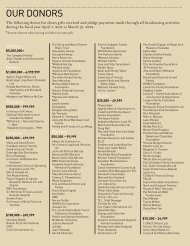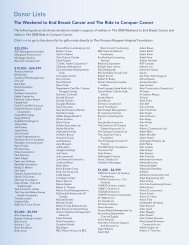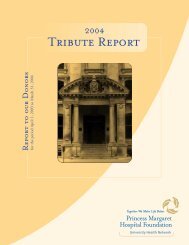Click here - The Princess Margaret Hospital Foundation
Click here - The Princess Margaret Hospital Foundation
Click here - The Princess Margaret Hospital Foundation
You also want an ePaper? Increase the reach of your titles
YUMPU automatically turns print PDFs into web optimized ePapers that Google loves.
analysis: exClUSIve<br />
World<br />
leaders<br />
in the<br />
fight<br />
against<br />
cancer<br />
Could you begin with a broad overview of the <strong>Princess</strong> <strong>Margaret</strong><br />
Cancer Centre? What role does it play within the University<br />
Health Network (UHN)?<br />
<strong>The</strong> Centre is the largest cancer research centre in Canada, and one<br />
of the largest in North America. We see 19,000 patients a year;<br />
13,000 of them with new cancers. We also have one of the largest<br />
radiotherapy centres in the world. We have a research institute, the<br />
Ontario Cancer Institute, with 65 independent laboratories and<br />
several cores. We also have an extremely active clinical research<br />
programme, with 165 clinician-investigators. On a yearly basis,<br />
about 25-30 per cent of our patients are on some form of clinical<br />
trial. We are the host institution for US National Cancer Institute<br />
(NCI)-funded Phase I and Phase II consortia – the only such sites<br />
located outside of the US. We also are the only member of the<br />
newly formed NCI Immune <strong>The</strong>rapy Network outside of the US. <strong>The</strong><br />
History<br />
of <strong>Princess</strong> <strong>Margaret</strong> <strong>Hospital</strong><br />
19<br />
52<br />
Founded as the Ontario Cancer<br />
Institute by the Ontario government<br />
19<br />
58<br />
14 international INNOvATION<br />
Officially opened by HRH<br />
<strong>Princess</strong> <strong>Margaret</strong>. Renamed<br />
<strong>Princess</strong> <strong>Margaret</strong> <strong>Hospital</strong><br />
Breakthroughs<br />
Wide use of cobalt radiotherapy for cancer<br />
Evidence that radiation can cure Hodgkin’s disease<br />
D r<br />
Benjamin<br />
Neel<br />
Director, Ontario Cancer Institute,<br />
<strong>Princess</strong> <strong>Margaret</strong> Cancer Centre<br />
Established more than 50 years ago,<br />
the <strong>Princess</strong> <strong>Margaret</strong> Cancer Centre<br />
now stands as the largest cancer<br />
research centre in Canada and one<br />
of the world’s top five. Dr Benjamin<br />
Neel highlights some of the Centre’s<br />
key accomplishments over the past<br />
decade, its ongoing programmes and<br />
ambitious plans for the future<br />
<strong>Princess</strong> <strong>Margaret</strong> Cancer Centre is part of UHN – which also includes<br />
Toronto General <strong>Hospital</strong>, Toronto Western <strong>Hospital</strong> and Toronto<br />
Rehabilitation Institute. <strong>The</strong> Centre is the only one to specialise in<br />
cancer medicine and research. All four hospitals are affiliated with<br />
the University of Toronto.<br />
<strong>The</strong> Centre is ranked as one of the world’s top five research<br />
centres. How has it gained such a strong reputation?<br />
This rating is based on a number of metrics, which include the<br />
percentage of high-impact papers and highly-cited papers, research<br />
funding, and clinical trials that lead to changes in clinical practice.<br />
Historically, major discoveries in basic cancer research (eg. the T<br />
cell receptor, the stem cell and the cancer stem cell), as well as<br />
translational/clinical research (eg. localised radiotherapy for breast<br />
cancer, practice standards for lung, pancreas and other cancers,<br />
Pioneered use of conservative surgery (lumpectomy)<br />
to treat breast cancer<br />
19<br />
59<br />
19<br />
61<br />
Discovery of blood-forming stem<br />
cells enabling bone marrow<br />
transplants<br />
19<br />
76<br />
Identified P-glycoprotein as<br />
a major cause of cancer drug<br />
resistance
19<br />
85<br />
20 November, 2006<br />
Rare stem cells<br />
found to cause colon cancer<br />
A groundbreaking study from UHN revealed that stem cells<br />
could be driving colon cancer.<br />
Scientists analysed tumour samples taken from patients with colon<br />
cancer and implanted them into mice with immune deficiency to see<br />
how different cancer cells behaved, and if some were more likely than<br />
others to produce tumours.<br />
<strong>The</strong> results revealed that not all cancer cells behaved the same and that<br />
stem cells were, in fact, responsible for generating the tumours in<br />
mice. <strong>The</strong>y also discovered that cancer-promoting stem cells were<br />
rare – one in every 57,000 cancer cells. “We found that not every<br />
tumour cell is equally capable of sustaining tumours in the<br />
colon,” explains Principal Investigator of the research<br />
and Senior Scientist at Ontario Cancer Institute, Dr<br />
John Dick. This finding could point the way to<br />
new treatments in the fight against<br />
cancer.<br />
18 January, 2007<br />
Breast density the #1<br />
risk factor for breast cancer<br />
<strong>The</strong> Campbell Family Institute for Breast Cancer Research<br />
at Prince <strong>Margaret</strong> discovered that breast cancer risk was<br />
almost five times greater in women with extensive dense tissue<br />
in the breast compared to those with little or no dense tissue. As<br />
risk remained high over a period of eight years, both at screening<br />
and between screens, the results show that in addition to increasing<br />
risk of breast cancer, dense breast tissue also makes cancers more<br />
difficult to see in a mammogram.<br />
“This study establishes that breast density is an extremely<br />
important risk factor for developing breast cancer,” says principal<br />
investigator Dr Norman Boyd. “Depending on a woman’s<br />
age, between 16-30 per cent of breast cancers can be<br />
attributed to extensive density. Other risk factors,<br />
including family history and the known<br />
genes, account for a much smaller<br />
proportion of the disease.”<br />
Discovery of the T-cell receptor,<br />
significant in the field of immunology<br />
19<br />
96<br />
Reopened by HRH <strong>Princess</strong> <strong>Margaret</strong><br />
at its current location on University<br />
Avenue, College Street, Toronto<br />
19<br />
96<br />
Developed a chemotherapy treatment<br />
for hormone-resistant prostate cancer<br />
19<br />
98<br />
Recent milestones<br />
mammographic density as a major cancer risk factor), were made at the<br />
<strong>Princess</strong> <strong>Margaret</strong> and its research arm, the Ontario Cancer Institute.<br />
What would you cite as your greatest achievements over the<br />
past 10 years?<br />
T<strong>here</strong> are several, but five that spring to mind are:<br />
• Gene signatures for lung cancer and leukaemia that predict outcome<br />
• Purification of the human and mouse hematopoietic stem cells to<br />
homogeneity<br />
• Identification of colon cancer stem cells<br />
• Credentialing of Avastin as the first new therapy for ovarian cancer in<br />
last 20 years<br />
• establishing mammographic density as the most important risk factor<br />
for breast cancer aside from BRCA1/2<br />
What kinds of research programmes are currently being<br />
undertaken at the Centre?<br />
We have major programmes in: normal and cancer stem cells (the<br />
latter focused on leukaemia, colon, head and neck, kidney, and ovarian);<br />
hypoxia, with a particular focus on its role in radiation response;<br />
epigenetics and epigenomics; precision genomic medicine with nextgeneration<br />
sequencing (NGS) partnered to clinical trials and targeted<br />
therapy; cancer immunology/immune therapy; molecular imaging;<br />
image-guided radiotherapy and surgery; and regenerative medicine.<br />
Could you outline the research facilities at the Centre? Do you<br />
have plans to enhance them further in the future?<br />
We are situated in three locations around Toronto’s ‘Discovery District’<br />
– so named because of its high concentration of hospitals and research<br />
institutions (particularly those related to biotechnology) and proximity<br />
to the University of Toronto. This is the district w<strong>here</strong> Drs Banting and<br />
Best discovered insulin in 1922, and Drs Till and McCulloch discovered<br />
stem cells in 1961.<br />
Our research facilities occupy six floors in the main <strong>Princess</strong> <strong>Margaret</strong><br />
buildings at 610/620 University Ave., and five floors in the Toronto<br />
Medical Discoveries Tower (TMDT) building across the street. We plan to<br />
expand TMDT to three additional floors in the summer of 2013. We have<br />
two fully equipped barrier vivaria and flow cytometry facilities at both<br />
locations, as well as a genomics centre, multi-modal animal imaging<br />
Became part of the University Health<br />
Network (UHN) – with Toronto General<br />
Identified gene clusters in lung cancer<br />
using microarray technology<br />
and Toronto Western hospitals – this is the<br />
largest cancer programme in the country<br />
20<br />
02<br />
20<br />
03<br />
analysis: exClUSIve<br />
Developed a method for detecting gene<br />
mutations to enhance care for<br />
families with retinoblastoma<br />
WWW.ReSeARCHMeDIA.eU 15
analysis: exClUSIve<br />
20<br />
07<br />
7 September 2010<br />
Gene sequence discovery<br />
to provide roadmap for lung<br />
cancer treatment<br />
UHN scientists pinpointed a gene sequence that<br />
could guide the treatment of patients with a particular<br />
type of lung cancer, finding that the 15-gene signature<br />
could potentially identify patients with early stage nonsmall<br />
cell lung cancer.<br />
This is a major breakthrough in patient care<br />
because up until now doctors have been unable<br />
to predict which patients with early-stage nonsmall<br />
cell lung cancer will benefit from<br />
chemotherapy post surgery.<br />
core, a mass spectrometry facility, NMR spectrometers and x-ray<br />
crystallography and a histology core at TMDT.<br />
We plan to add a mass cytometer to our flow facility and several new<br />
NGS instruments with associated high performance computing to our<br />
genomics capabilities.<br />
Our clinical research space uses over 350 individual outpatient clinics,<br />
imaging, laboratory medicine and pathology facilities.<br />
How does the atmosp<strong>here</strong> at the Centre foster and enhance the<br />
development of trainee researchers?<br />
<strong>The</strong> co-localisation of clinician scientists, basic scientists and clinicians<br />
facilitates interactions. We also have a weekly faculty lunch at which an<br />
investigator presents ongoing unpublished research and a yearly retreat<br />
focused on promoting interactions. We also have specific large ($0.5-1<br />
million) translational research grants that must involve at last one basic<br />
scientist and one clinician or clinician-scientist.<br />
What are your goals for future research at the Centre?<br />
• Provide a detailed molecular diagnosis of every patient’s tumour in<br />
real time within five years<br />
• Develop serum/blood-based molecular monitoring<br />
• Increase clinical trials of targeted therapies and targeted<br />
therapeutic combination<br />
Discovery of breast tissue<br />
density as major breast cancer risk<br />
20<br />
07<br />
16 international INNOvATION<br />
Discovery of colon-cancer<br />
causing stem cells<br />
20<br />
08<br />
• Increase our presence in immune therapy, including cell-based (TIl)<br />
therapies and immunomodulators<br />
• Increase our expertise in epigenetics and help bring epigenetic therapy<br />
to the clinic<br />
• Increase our molecular imaging expertise and use of molecular<br />
imaging in clinical trials<br />
• Develop improved cancer models, including xenografts and human eS<br />
cell-based models<br />
• Improve therapeutic ratio of clinical interventions with image-guided<br />
therapies<br />
• Bring normal tissue protection and<br />
regeneration into cancer therapeutics<br />
Celebrated its 50 th anniversary. City<br />
of Toronto presented a congratulatory<br />
scroll to mark the occasion<br />
20<br />
08<br />
29 December 2011<br />
New drug gives hope to<br />
ovarian cancer sufferers<br />
An international clinical trial revealed that a new drug,<br />
known as ‘Avastin’, not only halts the progression of<br />
ovarian cancer but may even increase survival rates. <strong>The</strong><br />
seven-year study co-led by Drs Amit Oza, <strong>Princess</strong> <strong>Margaret</strong><br />
Cancer Program, UHN and Timothy Perren, St James’s<br />
Institute of Oncology, Leeds, UK found that on average the<br />
cancer was delayed from returning for up to two months.<br />
“This is the first new drug in ovarian cancer in 15 years to<br />
improve outcome and I believe it should be considered<br />
as a potential new standard of care,” Oza enthused.<br />
<strong>The</strong> results also suggest that the drug could<br />
prolong patients’ lives and the extent of<br />
this possibility is currently under<br />
investigation.<br />
www.theprincessmargaret.ca<br />
Treated more than 350,000 new<br />
cancer patients since it first opened<br />
20<br />
12<br />
Renamed the <strong>Princess</strong> <strong>Margaret</strong> Cancer<br />
Centre, one of the Top 5 comprehensive<br />
cancer centres in the world





